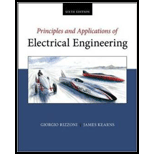
Concept explainers
Find the Thé venin equivalent resistance seen byresistor
The Thevenin equivalent resistance seen by the resistor
Answer to Problem 3.62HP
The Thevenin equivalent resistance is
Explanation of Solution
Calculation:
The given diagram is shown in Figure 1
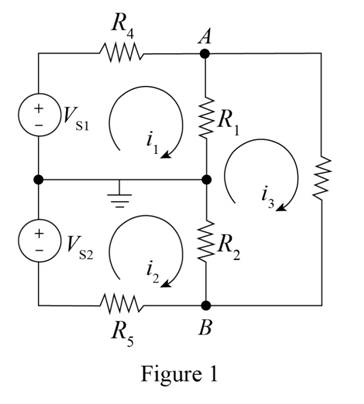
To calculate the value of Thevenin equivalent resistance, short circuit the voltage source and open circuit the current source, open circuit the load resistance
The required diagram is shown in Figure 2
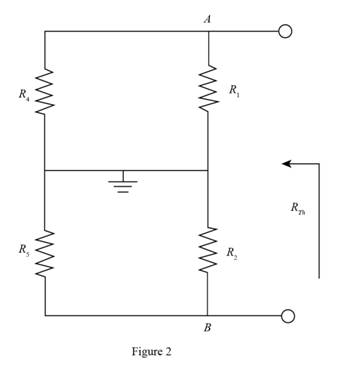
From the above figure the expression for the equivalent resistance of the circuit is evaluated as,
The expression for the Thevenin resistance of the circuit is given by,
Substitute
To calculate the open circuit voltage of the circuit, open circuit the load resistance and redraw the circuit.
The required diagram is shown in Figure 3

The expression to evaluate the voltage across the resistance
The expression to evaluate the voltage across the resistance
The expression for the open circuit voltage is given by,
Substitute
Mark the values and draw the Thevenin equivalent seen by the loadresistance
The required diagram is shown in Figure 4
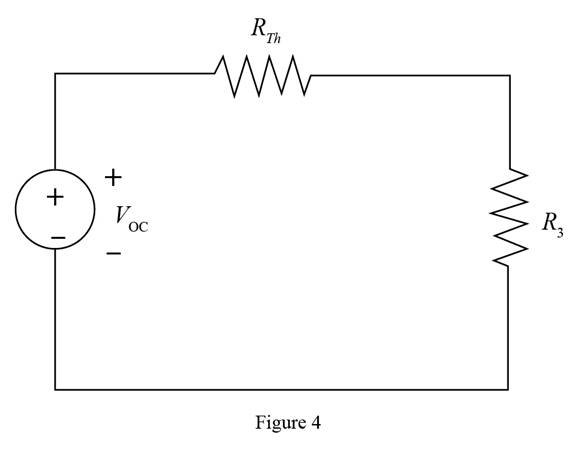
The expression for the Norton equivalent resistance is given by,
Substitute
To find the Norton current, short circuit the load resistance and redraw the circuit.
The required diagram is shown in Figure 5
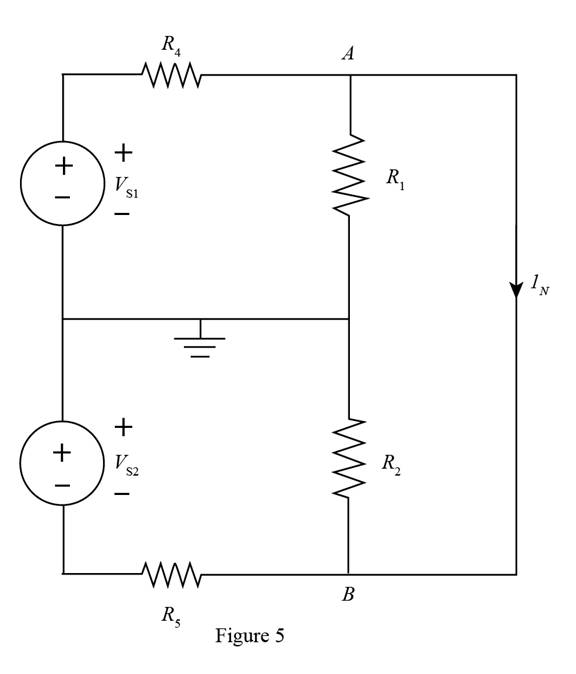
To obtain the Norton current convert the voltage sources of the above circuit into current source and redraw the circuit..
The required diagram is shown in Figure 6
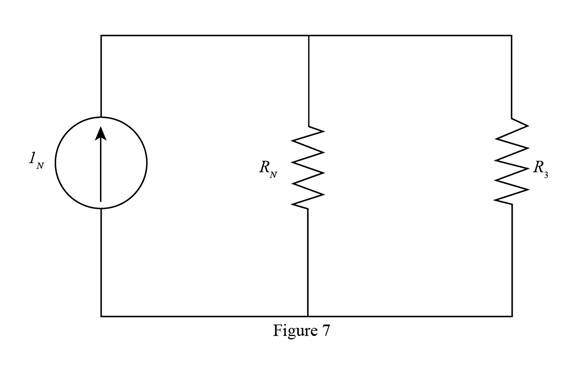
The resistance
The resistance
The expression for the Norton current is given by,
Mark the values and draw the Norton equivalent of the circuit.
The required diagram is shown in Figure 7

Conclusion:
Therefore, the Thevenin equivalent resistance is
Want to see more full solutions like this?
Chapter 3 Solutions
Principles and Applications of Electrical Engineering
- The circuit below shows a source driving a load. The current source is given by:i(t) = 6 cos (500t – 45) A(a) Calculate the value of the complex power delivered bythe source to the load when R = 5Ω and C = 10µF.(b) Determine an expression for the phasor-transformedvoltage V(jω) across the load, when the source delivers2.2 + 6.5j var (volt-amps reactive) to the load.arrow_forwardFor the circuit shown below, V1 = 10 sin(ωt) andV2 = 2 sin(ωt). Determine an expression for the voltage at thenode (between the inductor, capacitor and resistor) andhence determine the current flowing through the inductorarrow_forwardThe circuit shown in the figure below has been left for a longtime before the switch is opened at time t=0s. Determine anexpression for the current labelled i after the switch isopened. In your answer explain whether the response is validfor t≥0s or t>0sarrow_forward
- Show handwriting solutions not Aiarrow_forwardMaul Dulde Questio119 819 PREV NEXT In the lab, you have setup a thermocouple and have used a thermistor along with an ice bath and water at various temperatures (confirmed with the thermistor) up to 100 degrees Celsius for calibration. The calibration data is shown in the table below and the full-scale output range is 0-5 mV. You note that there is scatter in your data; however, you must use a linear curve fit to efficiently process the measurements during an automated temperature measurement process. Question 1 100% Question 2 100% Question 3 100% Question 4 100% Question 5 100% Question 6 100% mV The slope of your linear calibration curve for the thermocouple is 0.0334 °C with an offset of -0.07 mV. Question 7 100% Question 8 100% What is the maximum expected linearity error as a percentage of the full-scale output? Question 9 0% Summary -0.08 Thermocouple Calibration Data Temperature (°C) Voltage (in mV) 0 20 20 40 40 60 60 60 80 96 90 0.587 1.314 1.901 2.528 2.782 100 3.055 LIT…arrow_forwardOnly expert should solve itarrow_forward
- What is the high cutoff frequency? What is the low cutoff frequency? What is the bandwidth?arrow_forwardNeed handwritten pen and paper solution do not use chatgpt or AI otherwise downvote. An AC motor with impedance Z₁ = 4.2 + j3.6 ohm is supplied from a source of 220 V at 60 Hz. Find: a) pf, P and Q, b) Determine the capacitor required to connect in parallel with the motor so that the power factor is corrected and equal to 0.98 behind.arrow_forwardNeed handwritten pen and paper solution do not use chatgpt or AI otherwise downvote An AC motor with impedance Z₁ = 4.2 + j3.6 ohm is supplied from a source of 220 V at 60 Hz. Find: a) pf, P and Q, b) Determine the capacitor required to connect in parallel with the motor so that the power factor is corrected and equal to 0.98 behind.arrow_forward
 Introductory Circuit Analysis (13th Edition)Electrical EngineeringISBN:9780133923605Author:Robert L. BoylestadPublisher:PEARSON
Introductory Circuit Analysis (13th Edition)Electrical EngineeringISBN:9780133923605Author:Robert L. BoylestadPublisher:PEARSON Delmar's Standard Textbook Of ElectricityElectrical EngineeringISBN:9781337900348Author:Stephen L. HermanPublisher:Cengage Learning
Delmar's Standard Textbook Of ElectricityElectrical EngineeringISBN:9781337900348Author:Stephen L. HermanPublisher:Cengage Learning Programmable Logic ControllersElectrical EngineeringISBN:9780073373843Author:Frank D. PetruzellaPublisher:McGraw-Hill Education
Programmable Logic ControllersElectrical EngineeringISBN:9780073373843Author:Frank D. PetruzellaPublisher:McGraw-Hill Education Fundamentals of Electric CircuitsElectrical EngineeringISBN:9780078028229Author:Charles K Alexander, Matthew SadikuPublisher:McGraw-Hill Education
Fundamentals of Electric CircuitsElectrical EngineeringISBN:9780078028229Author:Charles K Alexander, Matthew SadikuPublisher:McGraw-Hill Education Electric Circuits. (11th Edition)Electrical EngineeringISBN:9780134746968Author:James W. Nilsson, Susan RiedelPublisher:PEARSON
Electric Circuits. (11th Edition)Electrical EngineeringISBN:9780134746968Author:James W. Nilsson, Susan RiedelPublisher:PEARSON Engineering ElectromagneticsElectrical EngineeringISBN:9780078028151Author:Hayt, William H. (william Hart), Jr, BUCK, John A.Publisher:Mcgraw-hill Education,
Engineering ElectromagneticsElectrical EngineeringISBN:9780078028151Author:Hayt, William H. (william Hart), Jr, BUCK, John A.Publisher:Mcgraw-hill Education,





